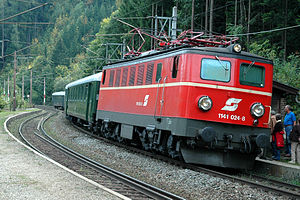ÖBB 1141
| ÖBB 1141 | |
|---|---|
| Numbering: | 1141.01 to 1141.30 from 1986 1141 001 to 1141 030 |
| Number: | 30th |
| Manufacturer: | AEG, BBC, ELIN, SSW, SGP |
| Year of construction (s): | 1955-1958 |
| Retirement: | 2003 |
| Axis formula : | Bo'Bo ' |
| Length over buffers: | 15,260 mm |
| Service mass: | 83 t |
| Top speed: | 110 km / h |
| Hourly output : | 2,480 kW |
| Starting tractive effort: | 210 kN |
| Power system : | 15 kV / 16.7 Hz |
| Number of traction motors: | 4th |
| Drive: | Rubber ring spring |
| Brake: | Additional brake and air brake |
The ÖBB 1141 represents a further development of the electric locomotive series 1041 of the Austrian Federal Railways .
history
After the Second World War, the Austrian Federal Railways needed new electric locomotives for their extensive electrification program , which was supposed to replace the steam traction . Since the repair of the most important Austrian railway lines progressed rapidly, new locomotives were also required. The demand was initially met with the new construction locomotive series 1040 and 1041 . Since the locomotives of the 1041 series had proven themselves extremely well, the ÖBB decided on a further development, which was called the 1141 series. The ÖBB stipulated a maximum speed of 110 km / h, a maximum service weight of 80 t and an output of 3,000 kW as minimum requirements; the previous series only had a top speed of 90 km / h, which is why it was soon superseded from use on the main routes. Between 1955 and 1958 30 machines were delivered to the ÖBB. SGP Graz was responsible for the mechanical part, the electrical part was manufactured by the companies AEG , BBC , ELIN and SSW . All locomotives were painted pine green when they were delivered, the frame and running gear were painted black. In 1957 a test locomotive commissioned by the ÖBB was delivered. It was a two-system locomotive, which was referred to as the 1050 series and looked completely like the 1141 series. After the 1050.01 was taken out of service in 1973, it was converted to the 1141.03 II, as the original 1141.03 was irreparably damaged in an accident in Fürnitz on May 1, 1971. After several years of service, the 1141s were given a blood-orange color, some were later painted in traffic red, and some of the driver's cab doors were laminated and moved to the rear of the engine room.
After delivery, the 1141 series locomotives were used on the western and southern tracks in express train service. Over time, however, they were replaced by the 1042 series . Last the 1141 were stationed in Attnang-Puchheim . In 2003 all locomotives in this series were withdrawn from the ÖBB's inventory. The last representatives were 1141.007, 020, 021, 022, 024 and 028. Later 1141.019 and 1141.024 went into operation at the ProLok railway company. The locomotives 1141.003 (1141.03 II), 1141.007, 1141.020, 1141.021 and 1141.028 have been preserved as nostalgic locomotives.
construction
mechanical construction
The car body largely corresponded to the previous series 1041. In order to make the locomotive as light as possible (the 80-tonne limit set by the ÖBB was not allowed to be exceeded), the bogie frames were designed as a spar construction; In addition, the bogies showed improved cornering ability. The tensile force was transmitted in the same way as with the 1041 series. The box, welded from sheet steel, was supported on sliding blocks at the end of the weighing beam. The engine room and a connecting passage were located between the two driver's cabs, the transformer was in the middle of the locomotive. The well-known and proven Siemens rubber ring spring drive (a hollow shaft drive) was installed for the first time in the class 1141 locomotives . All auxiliary units and other devices were housed in the engine compartment. Some locomotives received a modified box in the course of repair work.
Electric Construction
The roof carried two pantographs with double rockers (type V), the main switch and all roof cables. The externally ventilated and oil-cooled transformer was located under the main switch; it was slightly modified compared to the 1041 series, but the controls were retained. The locomotives had four engines , the gear ratio of the gearbox was 23:88. All locomotives had an automatically acting compressed air brake, an after-brake valve and a direct-acting auxiliary brake. The machines were not equipped with an electric brake as in the previous series for reasons of weight.
literature
- Klaus-J. Vetter: The great manual for electric locomotives. Sconto, Munich 2003, ISBN 3-7654-4066-3 .
- Markus Inderst : Picture atlas of the ÖBB locomotives. All traction vehicles of the Austrian Federal Railways. GeraMond, Munich 2010, ISBN 978-3-7654-7084-4 .

